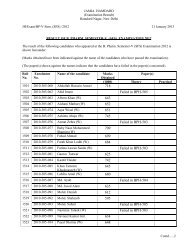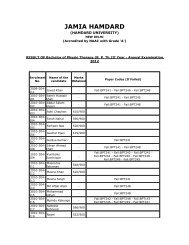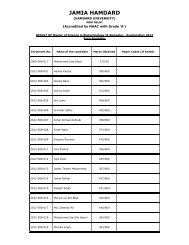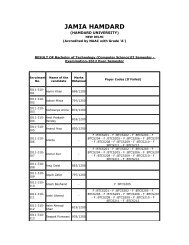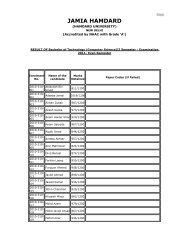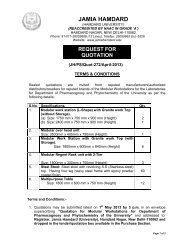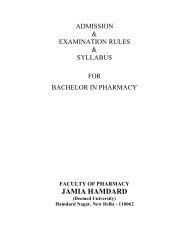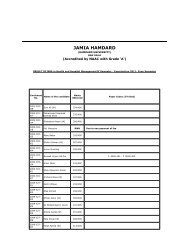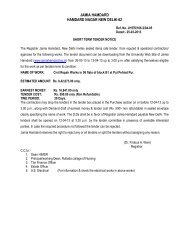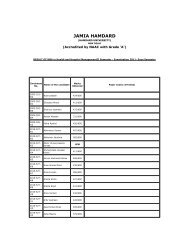Unani Formulation - Jamia Hamdard
Unani Formulation - Jamia Hamdard
Unani Formulation - Jamia Hamdard
Create successful ePaper yourself
Turn your PDF publications into a flip-book with our unique Google optimized e-Paper software.
Afiun (Papaver somniferum Linn latex) and Rasaut (Berberis aristata<br />
extract)<br />
Afiun (Papaver somniferum Linn latex) or Rasaut (Berberis aristata<br />
extract) is cut into small pieces and soaked in Arq-e-Gulab for 24<br />
hours. It is then stirred well and sieved through a clean piece of fine<br />
cloth into a big cylindrical glass and the sediments are allowed to<br />
settle down. The liquid is then decanted into another vessel without<br />
disturbing the sediment and boiled till it becomes a thick mass. The<br />
purified Afiun or Rasaut is called Afiun or Rasaut Musaffa.<br />
Anzroot (Astragallus sarcacola gum)<br />
Make the powder of Anzroot (Astragallus sarcacola gum). Mix the<br />
powder with mother’s milk or donkey’s milk to form a paste. The<br />
paste is smeared over a piece of Jhau wood (Tamarix wood) and<br />
dried directly over dung cake fire. When it is dried completely,<br />
remove it from wood and store for use.<br />
Azaraqi (Strychnos nuxvomica Linn fruit)<br />
60gm of Azaraqi (Strychnos nuxvomica Linn fruit) is soaked in<br />
water for seven days. Change water daily or buried in soil/clay and<br />
water is poured over it daily for seven or ten days. The Azaraqi is<br />
then taken out and washed. Their fleshy outer covering (Testa) is<br />
peeled off with the knife and the kernels of Azaraqi (Strychnos<br />
nuxvomica Linn fruit kernel) are separated. Remove the embryo part.<br />
It is then washed with hot water and tied in a clean cloth bag. The<br />
bag is immersed in a vessel containing two litres of milk. The milk is<br />
then boiled till it evaporates, care being taken that the bag should not<br />
touch the bottom of the vessel. Thereafter, Azaraqi is removed from<br />
the bag and washed thoroughly with water to obtain Azaraqi<br />
Mudabbar. Some experts make bead of Azaraqi instead of tightening<br />
in cloth and hang it in milk to complete the process.<br />
Kibreet or Gandhak (Sulphur)<br />
One part of Gandhak Amlasar and two parts of Roghan Zard (Ghee)<br />
are taken in a Karchha (laddle) and kept on a low fire. When Gandhak<br />
is melted, four parts of the milk is added. This process is repeated at<br />
least three times changing the fresh Ghee and milk each time to obtain<br />
Gandhak Mudabbar.<br />
Other process: A clay pan or steel pan is half filled with milk. A<br />
cloth is tighten on the mouth of the pot. Gandhak (Sulphur) is kept<br />
on this cloth. An iron plate is kept on mouth of the pot as it covers the<br />
Gandhak (Sulphur). Hot charcoal is kept on iron plate. Give low heat<br />
to milk from under side. Getting heat from hot charcoal, Gandhak<br />
(Sulphur) is melted and goes in milk. Let it be cool. It is then<br />
collected.<br />
Sammulfar, Sankhiya (Arsenic)<br />
Make fine powder of Sammulfar (Arsenic), immerse in sufficient<br />
quantity of fresh Aab-e-Leemun (Citrus lemonum fruit juice) and<br />
ground in a Mortar of China clay or glass till the juice is completely<br />
absorbed. This process is repeated seven times to obtain Sammulfar<br />
or Sankhiya Mudabbar.<br />
Shingarf (Mercuric chloride)<br />
Shingarf is ground with fresh Aab Leemun (Citrus lemonum fruit<br />
juice) till it is absorbed and a fine powder is obtained. This process is<br />
repeated three times to obtain Shingarf Mudabbar.<br />
25 26




![BCA_2010[1] - Jamia Hamdard](https://img.yumpu.com/23632500/1/190x245/bca-20101-jamia-hamdard.jpg?quality=85)
